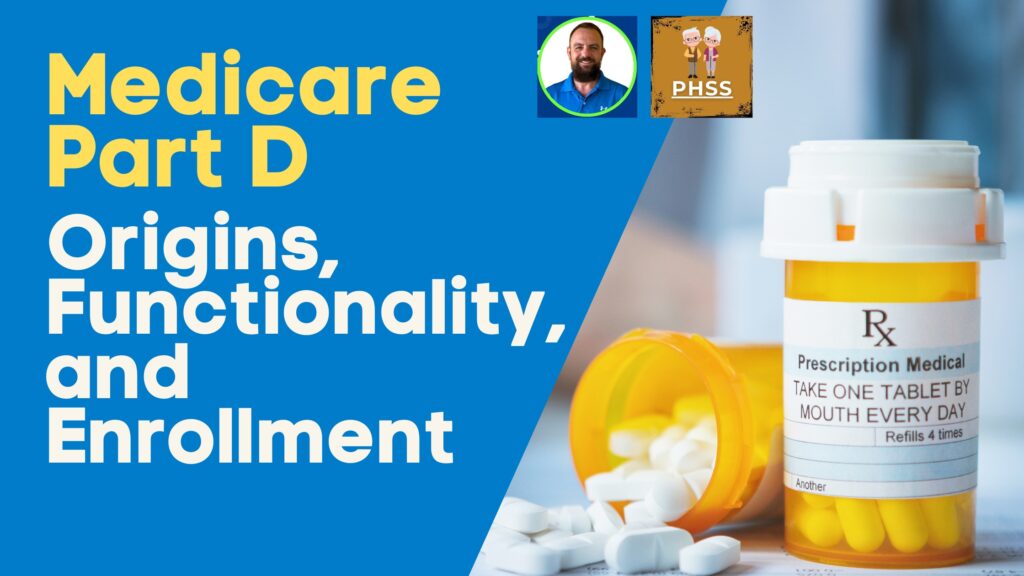727-777-3608
Local Agent: Daniel
Local Agent: Daniel

Medicare Part D is a program designed to provide prescription drug coverage for seniors and disabled individuals in the United States. Launched as a part of the Medicare Prescription Drug, Improvement, and Modernization Act of 2003, the program was aimed at reducing the financial burden of prescription drugs. This article “Medicare Part D: Origins, Functionality, and Enrollment” explores the origins, functionality, qualifications, and the enrollment process for Medicare Part D.
It is my intention to answer most of your questions in this article, but if I miss something please email me at daniel@pascohernandoseniorservices.org and I will answer your question.
Medicare Part D was enacted on December 8, 2003, with the signing of the Medicare Modernization Act by President George W. Bush. The law was designed to address the growing concern over the high cost of prescription drugs, especially for those on a fixed income. Before this program, Medicare did not provide coverage for most outpatient prescription drugs, leaving a significant gap in healthcare coverage.
The program was officially implemented on January 1, 2006, allowing beneficiaries access to a wider range of prescription drug coverage options through private insurance companies.
Medicare Part D provides prescription drug coverage to those eligible for Medicare. It operates through private insurance plans approved by Medicare, which means that the specific coverage, copayments, and premiums can vary by plan and location.
Here’s what Medicare Part D typically covers:
The program covers a wide range of both brand-name and generic drugs, with different plans offering various lists of covered medications.
Most Part D plans categorize drugs into tiers, with different cost-sharing amounts for each tier. Lower-tier drugs usually have lower costs, while higher-tier drugs may cost more.
For those with limited income and resources, Extra Help is a program designed to assist with Part D premiums, deductibles, and copayments.
Enrollees choose a Part D plan offered by private insurance companies in their service area. These plans must meet federal standards but can differ in cost, covered medications, and pharmacy networks. Here’s how it generally works:
Individuals choose a plan during the eligible enrollment periods.
Enrollees pay a monthly premium and may have an annual deductible.
After meeting the deductible, enrollees pay a copayment or coinsurance for each prescription.
After spending a certain amount, enrollees enter a coverage gap where they pay a higher percentage of drug costs. Once a spending threshold is reached, catastrophic coverage begins, lowering out-of-pocket costs.
Here’s a guide to when and how individuals can enroll in Medicare Part D:
Initial Enrollment Period (IEP): This is a 7-month window that begins three months before the month an individual turns 65, includes the birthday month, and extends three months after the birthday month.
Annual Election Period (AEP): Between October 15 and December 7 each year, individuals can join, switch, or drop a Part D plan.
Special Enrollment Periods (SEPs): Under certain circumstances, like moving out of the plan’s service area or losing other credible prescription drug coverage, individuals can make changes outside the regular enrollment periods.
Late Enrollment Penalty: If individuals don’t sign up when first eligible and don’t have other credible prescription drug coverage, they may face a penalty when they do enroll.
To enroll, individuals can visit the Medicare website, call the Medicare helpline, or apply through an insurance company offering a Part D plan in their area.
Medicare Part D was a landmark achievement that substantially expanded prescription drug coverage for seniors and disabled individuals in the United States. By understanding the origins, how the program functions, the qualifications, and the process of enrollment, individuals can make informed decisions that align with their healthcare needs and financial situations.
With various options available, prospective enrollees should consider their specific needs and consult with a Medicare specialist or use online tools to find the best Part D plan for them.
If you have questions about Medicare, don’t hesitate to contact one of our local agents who work in your community. Visit PascoHernandoSeniorServices.org to schedule an appointment.
Disclaimer: All content is provided for informational purposes only and is subject to change without notice. Although we believe that the source of this information is reliable, we do not warrant or guarantee its accuracy, completeness, or timeliness.
PascoHernandoSeniorServices.org, our staff, internal agents, or our contracted agents, are not employed or endorsed by any federal or state agencies or programs. We have independent contracts with many different insurance companies to offer their products to eligible consumers.
We do not offer every medicare advantage (Part C) plan or prescription drug (Part D) plan available in your area. Any information we provide is limited to the plans offered by Humana, UHC, Wellcare, BayCare & Aetna. Please contact Medicare.gov, 1-800-MEDICARE, or your local State Health Insurance Program to get information on all of your options.”
Some links on our website may take you to a third-party website. Those websites have their own Privacy Policies and we encourage you to read them as we have no control over those websites. Some links may also be affiliate links, in which case we may receive a commission if you chose to buy anything through those links.
By submitting your contact information, you agree to be contacted even if you are on any internal, state, or national “Do Not Call” lists. Please read our full privacy policy before submitting your information.
Click Here To Read Our Privacy Policy.
You have the option of opting out of any and all communication with us by simply replying to any email we send you or by just emailing your local agent at daniel@pascohernandoseniorservices.org.
Your local agent will email you a quote for $10k, $15k & $20k. If you need any other amounts, just add them to the comment section. Click here if you would like to read our privacy policy & terms of use.